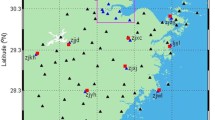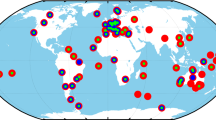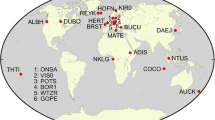Abstract
Global Positioning System (GPS) has become a cost-effective tool to determine troposphere zenith total delay (ZTD) with accuracy comparable to other atmospheric sensors such as the radiosonde, the water vapor radiometer, the radio occultation and so on. However, the high accuracy of GPS troposphere ZTD estimates relies on the precise satellite orbit and clock products available with various latencies. Although the International GNSS Service (IGS) can provide predicted orbit and clock products for real-time applications, the predicted clock accuracy of 3 ns cannot always guarantee the high accuracy of troposphere ZTD estimates. Such limitations could be overcome by the use of the newly launched IGS real-time service which provides \(\sim \)5 cm orbit and 0.2–1.0 ns (an equivalent range error of 6–30 cm) clock products in real time. Considering the relatively larger magnitude of the clock error than that of the orbit error, this paper investigates the effect of real-time satellite clock errors on the GPS precise point positioning (PPP)-based troposphere ZTD estimation. Meanwhile, how the real-time satellite clock errors impact the GPS PPP-based troposphere ZTD estimation has also been studied to obtain the most precise ZTD solutions. First, two types of real-time satellite clock products are assessed with respect to the IGS final clock product in terms of accuracy and precision. Second, the real-time GPS PPP-based troposphere ZTD estimation is conducted using data from 34 selected IGS stations over three independent weeks in April, July and October, 2013. Numerical results demonstrate that the precision, rather than the accuracy, of the real-time satellite clock products impacts the real-time PPP-based ZTD solutions more significantly. In other words, the real-time satellite clock product with better precision leads to more precise real-time PPP-based troposphere ZTD solutions. Therefore, it is suggested that users should select and apply real-time satellite products with better clock precision to obtain more consistent real-time PPP-based ZTD solutions.





Similar content being viewed by others
References
Ahmed F, Václavovic P, Teferle FN, Douša J, Bingley R, Laurichesse D (2014) Comparative analysis of real-time precise point positioning zenith total delay estimates. GPS Solut. doi:10.1007/s10291-014-0427-z
Baelen JV, Aubagnac JP, Dabas A (2005) Comparison of near-real time estimates of integrated water vapor derived with GPS, radiosondes, and microwave radiometer. J Atmos Ocean Tech 22(2):201–210
Bevis M, Businger S, Chiswell S, Herring TA, Anthes RA, Rocken C, Ware RH (1992) GPS meteorology: remote sensing of atmospheric water vapor using the global positioning system. J Geophys Res 97(D14):15787–15801
Boehm J, Niell A, Tregoning P, Schuh H (2006) Mapping function (GMF): a new empirical mapping function based on numerical weather model data. Geophys Res Lett 33:L07304
Boehm J, Heinkelmann R, Schuh H (2007) Short note: a global model of pressure and temperature for geodetic applications. J Geod 81(10):679–683
Byun S, Bar-Sever Y (2009) A new type of troposphere zenith path delay product of the international GNSS service. J Geod 83(3–4):1–7
Caissy M, Agrotis L, Weber G, Hernandez-Pajares M, Hugentobler U (2012) Coming soon: the international GNSS real-time service. GPS World 23(6):52–58
Chen J, Li H, Wu B, Zhang Y, Wang J, Hu C (2013) Performance of real-time precise point positioning. Mar Geod 36:98–108
Dousa J (2010) The impact of errors in predicted GPS orbits on zenith troposphere delay estimation. GPS Solut 14:229–239
Dousa J, Vaclavovic P (2014) Real-time zenith tropospheric delays in support of numerical weather prediction applications. Adv Space Res 53(9):1347–1358
Dow M, Neilan E, Rizos C (2009) The International GNSS Service in a changing landscape of Global Navigation Satellite Systems. J Geod 83(3–4):191–198
Duan J, Bevis M, Fang P, Bock Y, Chiswell S, Businger S, Rocken C, Solheim F, Hove TV, Ware R, Mcclusky S, Herring TA, King RW (1995) GPS meteorology: direct estimation of the absolute value of precipitable water. J Appl Meteorol Clim 35:830–838
Gao Y, Shen X (2002) A new method for carrier phase based precise point positioning. Navigation 49(2):109–116
Gérard P, Luzum B (2010) IERS conventions 2010. http://www.iers.org/nn_11216/SharedDocs/Publikationen/EN/IERS/Publications/tn/TechnNote36/tn36,templateId=raw,property=publicationFile.pdf/tn36.pdf
Haan SD, Holleman I, Holtslag AAM (2009) Real-time water vapor maps from a GPS surface network: construction, validation, and applications. J Appl Meteorol Clim 48:1302–1316
Hadas T, Bosy J (2014) IGS RTS precise orbits and clocks verification and quality degradation over time. GPS Solut. doi:10.1007/s10291-014-0369-5 (online first)
Karabatic A, Weber R, Haiden T (2011) Near real-time estimation of tropospheric water vapour content from ground based GNSS data and its potential contribution to weather now-casting in Austria. Adv Space Res 47:1691–1703
Li X, Zhang X, Ge M (2011) Regional reference network augmented precise point positioning for instantaneous ambiguity resolution. J Geod 85(3):151–158
Li X, Dick G, Ge M, Heise S, Wickert J, Bender M (2014) Real-time GPS sensing of atmospheric water vapor: precise point positioning with orbit, clock, and phase delay corrections. Geophys Res Lett 41(10):3615–3621
Liou Y, Huang C (2000) GPS observations of PW during the passage of a typhoon. Earth Planets Space 52:709–712
Liou Y, Teng Y, Hove TV, Liljegren JC (2001) Comparison of precipitable water observations in the near tropics by GPS, microwave radiometer, and radiosondes. J Appl Meteorol Clim 40:5–15
Liu Z, Li M (2013) The first PPP-based GPS Water Vapor Real-Time Monitoring System in Pearl-River-Delta Region, China. In: Proceedings of China Satellite Navigation Conference
Loyer S, Perosanz F, Mercier F, Capdeville H, Marty JC (2012) Zero-difference GPS ambiguity resolution at CNES-CLS IGS analysis center. J Geod 86(11):991–1003
Pacione R, Vespe F (2008) Comparative studies for the assessment of the quality of near-real-time GPS-derived atmospheric parameters. J Atmos Ocean Tech 25:701–714
RTCM Special Committee 104 (2011) Differential GNSS (Global Navigation Satellite Systems) services—version 3 + Amendments 1, 2, 3, 4, and 5 to RTCM 10403.1. https://ssl29.pair.com/dmarkle/puborder.php?show=3
Saastamoinen J (1972) Contributions to the theory of atmospheric refraction. Bull Géod 105:13–34
Satirapod C, Anonglekha S, Choi Y, Lee H (2011) Performance assessment of GPS-sensed precipitable water vapor using IGS ultra-rapid orbits: a preliminary study in Thailand. Eng J 15:1–8
Sato K, Realini E, Tsuda T, Oigawa M, Iwaki Y, Shoji Y, Seko H (2013) A high-resolution, precipitable water vapor monitoring system using a dense network of GNSS receivers. J Disaster Res 8:37–47
Schmid R, Steigenberger P, Gendt G, Ge M, Rothacher M (2007) Generation of a consistent absolute phase-center correction model for GPS receiver and satellite antennas. J Geod 81(12):781–798
Shi J, Gao Y (2014) A comparison of three PPP integer ambiguity resolution methods. GPS Solut 18(4):519–528
Shi J, Xu C, Guo J, Gao Y (2014) Local troposphere augmentation for real-time precise point positioning. Earth Planets Space 66:30
Shoji Y (2009) A study of near real-time water vapor analysis using a nationwide dense GPS network of Japan. J Meteorol Soc Jpn 87:1–18
Wang H, Wei M, Li G, Zhou S, Zeng Q (2013) Analysis of precipitable water vapor from GPS measurements in Chengdu region: distribution and evolution characteristics in autumn. Adv Space Res 52:656–667
Wu J, Wu S, Hajj G, Bertiger W, Lichten S (1993) Effects of antenna orientation on GPS carrier phase. Manuscr Geod 18:91–98
Yuan Y, Zhang K, Rohm W, Choy S, Norman R, Wang C (2014) Real-time retrieval of precipitable water vapor from GPS precise point positioning. J Geophys Res 119:10044–10057
Zumberge J, Heflin M, Jefferson D, Watkins M, Webb F (1997) PPP for the efficient and robust analysis of GPS data from large networks. J Geophys Res 102:5005–5017
Acknowledgments
IGS and CNES are acknowledged for providing GPS observation data, the post-mission and real-time satellite precise orbit and clock products. This work has been supported by the National Key Developing Program for Basic Sciences of China (Grant No. 2012CB719902), National Natural Science Foundation of China (Grant No. 41371432, 41474004), and Key Laboratory of Geospace Environment and Geodesy (Grant No. 2013-02-02).
Author information
Authors and Affiliations
Corresponding author
Rights and permissions
About this article
Cite this article
Shi, J., Xu, C., Li, Y. et al. Impacts of real-time satellite clock errors on GPS precise point positioning-based troposphere zenith delay estimation. J Geod 89, 747–756 (2015). https://doi.org/10.1007/s00190-015-0811-7
Received:
Accepted:
Published:
Issue Date:
DOI: https://doi.org/10.1007/s00190-015-0811-7




